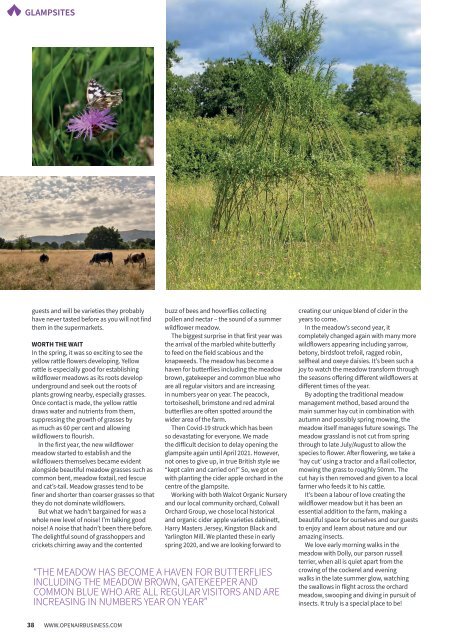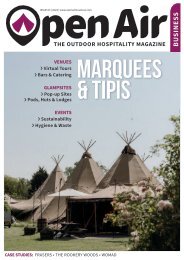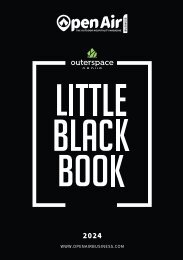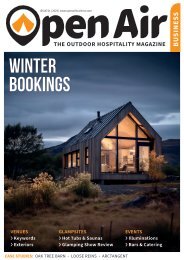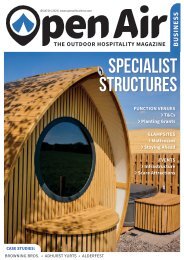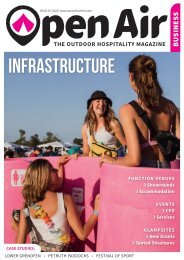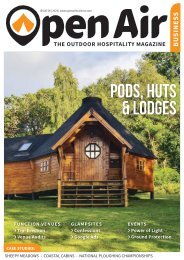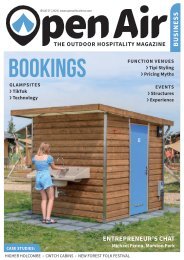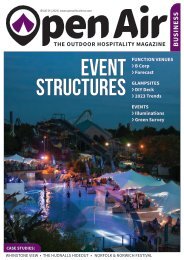May/June 2021
The UK's outdoor hospitality business magazine for function venues, glamping, festivals and outdoor events
The UK's outdoor hospitality business magazine for function venues, glamping, festivals and outdoor events
You also want an ePaper? Increase the reach of your titles
YUMPU automatically turns print PDFs into web optimized ePapers that Google loves.
GLAMPSITES<br />
guests and will be varieties they probably<br />
have never tasted before as you will not find<br />
them in the supermarkets.<br />
WORTH THE WAIT<br />
In the spring, it was so exciting to see the<br />
yellow rattle flowers developing. Yellow<br />
rattle is especially good for establishing<br />
wildflower meadows as its roots develop<br />
underground and seek out the roots of<br />
plants growing nearby, especially grasses.<br />
Once contact is made, the yellow rattle<br />
draws water and nutrients from them,<br />
suppressing the growth of grasses by<br />
as much as 60 per cent and allowing<br />
wildflowers to flourish.<br />
In the first year, the new wildflower<br />
meadow started to establish and the<br />
wildflowers themselves became evident<br />
alongside beautiful meadow grasses such as<br />
common bent, meadow foxtail, red fescue<br />
and cat’s-tail. Meadow grasses tend to be<br />
finer and shorter than coarser grasses so that<br />
they do not dominate wildflowers.<br />
But what we hadn’t bargained for was a<br />
whole new level of noise! I’m talking good<br />
noise! A noise that hadn’t been there before.<br />
The delightful sound of grasshoppers and<br />
crickets chirring away and the contented<br />
buzz of bees and hoverflies collecting<br />
pollen and nectar – the sound of a summer<br />
wildflower meadow.<br />
The biggest surprise in that first year was<br />
the arrival of the marbled white butterfly<br />
to feed on the field scabious and the<br />
knapweeds. The meadow has become a<br />
haven for butterflies including the meadow<br />
brown, gatekeeper and common blue who<br />
are all regular visitors and are increasing<br />
in numbers year on year. The peacock,<br />
tortoiseshell, brimstone and red admiral<br />
butterflies are often spotted around the<br />
wider area of the farm.<br />
Then Covid-19 struck which has been<br />
so devastating for everyone. We made<br />
the difficult decision to delay opening the<br />
glampsite again until April <strong>2021</strong>. However,<br />
not ones to give up, in true British style we<br />
“kept calm and carried on!” So, we got on<br />
with planting the cider apple orchard in the<br />
centre of the glampsite.<br />
Working with both Walcot Organic Nursery<br />
and our local community orchard, Colwall<br />
Orchard Group, we chose local historical<br />
and organic cider apple varieties dabinett,<br />
Harry Masters Jersey, Kingston Black and<br />
Yarlington Mill. We planted these in early<br />
spring 2020, and we are looking forward to<br />
“THE MEADOW HAS BECOME A HAVEN FOR BUTTERFLIES<br />
INCLUDING THE MEADOW BROWN, GATEKEEPER AND<br />
COMMON BLUE WHO ARE ALL REGULAR VISITORS AND ARE<br />
INCREASING IN NUMBERS YEAR ON YEAR”<br />
creating our unique blend of cider in the<br />
years to come.<br />
In the meadow’s second year, it<br />
completely changed again with many more<br />
wildflowers appearing including yarrow,<br />
betony, birdsfoot trefoil, ragged robin,<br />
selfheal and oxeye daisies. It’s been such a<br />
joy to watch the meadow transform through<br />
the seasons offering different wildflowers at<br />
different times of the year.<br />
By adopting the traditional meadow<br />
management method, based around the<br />
main summer hay cut in combination with<br />
autumn and possibly spring mowing, the<br />
meadow itself manages future sowings. The<br />
meadow grassland is not cut from spring<br />
through to late July/August to allow the<br />
species to flower. After flowering, we take a<br />
‘hay cut’ using a tractor and a flail collector,<br />
mowing the grass to roughly 50mm. The<br />
cut hay is then removed and given to a local<br />
farmer who feeds it to his cattle.<br />
It’s been a labour of love creating the<br />
wildflower meadow but it has been an<br />
essential addition to the farm, making a<br />
beautiful space for ourselves and our guests<br />
to enjoy and learn about nature and our<br />
amazing insects.<br />
We love early morning walks in the<br />
meadow with Dolly, our parson russell<br />
terrier, when all is quiet apart from the<br />
crowing of the cockerel and evening<br />
walks in the late summer glow, watching<br />
the swallows in flight across the orchard<br />
meadow, swooping and diving in pursuit of<br />
insects. It truly is a special place to be!<br />
38 WWW.OPENAIRBUSINESS.COM


